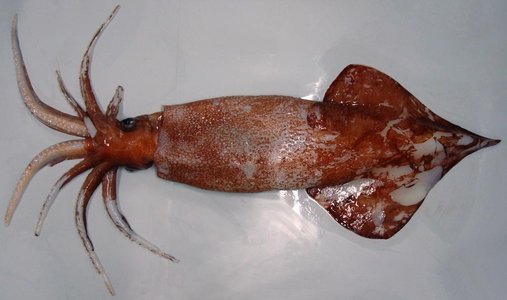Onykia (Onykia) robsoni
Michael Vecchione, Richard E. Young, and Kotaro TsuchiyaIntroduction
Adults of O. robsoni reach a length of 470 mm ML. This species apparently has the broadest distribution of any member of the genus.
Diagnosis
An Onykia ...
- with sagittate fins (fins drawn-out posteriorly).
- with warts rather than ridges on skin.
Characteristics
- Tentacles
- Club with 13-16 pairs of hooks.
Scanning electron micrographs of the hooks can be found here. Click on an image to view larger version & data in a new window
Click on an image to view larger version & data in a new window
Figure. Oral view of the tentacular clubs of O. robsoni, 260 mm ML. Photograph by D. Stevens.
-
- Club with 13-16 pairs of hooks.
- Head
- Beaks: Descriptions can be found here: Lower beak; upper beak.
- Beaks: Descriptions can be found here: Lower beak; upper beak.
- Mantle
- Covered with fleshy, irregular warts.
- Covered with fleshy, irregular warts.
- Fins
- Sagittate shape.
- Length 53-62% of ML at 156-370 mm ML.
- Width 51-70% of ML at 156-370 mm ML.
- Gladius
- Rostrum ventral length 23-36% of GL; triangular in cross-section.
Comments
The above data is from Kubodera et al., 1998. This species is very similar to O. robusta in the shape of the fins but is separated by the structure of the skin (i.e., warts vs ridges), and the fewer pairs of club hooks (13-16 vs 16-18).
Nomenclature
Onykia aequatorialis (Thiele, 1920) was described from the equatorial Atlantic at 18°07'W. Kubodera, et al., 1998, examined a spent female of O. robsoni from Bermuda that was very similar to O. aequatorialis which caused them to question the validity of the latter. Since the holotype has been lost and there are no distinguishing features in the type description, they designated O. aequatorialis a nomen dubium.
Life History


Figure. Ventral view of a young O. robsoni, 260 mm ML. Photograph by D. Stevens.
Distribution
The type locality is off Angola at 16° 36'S, 11°20'E. This species occurs north of the southern subtropical convergence, off southwestern Australia, New Zealand and southern Africa and it is indistinguishable from specimens taken from the Gulf of Mexico and off Bermuda in the North Atlantic (Kubodera, et al., 1998). It is also reported off the southwestern coast of South America.
References
Adam, W. 1962. Cephalopodes de l’Archipel du Cap-Vert, de l’Angola et du Mozambique. Memorias da Junta de Investigacoes do Ultramar, series 2, 33: 9-64.
T. Kubodera, U. Piatkowski, T. Okutani and M.R. Clarke. 1998. Taxonomy and Zoogeography of the Family Onychoteuthidae (Cephalopoda: Oegopsida). Smithsonian Contributions to Zoology, No. 586: 277-291.
Title Illustrations

| Scientific Name | Onykia robsoni |
|---|---|
| Reference | Kubodera, T., U. Piatkowski, T. Okutani and M.R. Clarke. 1998. Taxonomy and Zoogeography of the Family Onychoteuthidae (Cephalopoda: Oegopsida). Smithsonian Contributions to Zoology, No. 586: 277-291. |
| View | Dorsal |
| Scientific Name | Onykia (Onykia) robsoni |
|---|---|
| Location | S.W. Chatham Rise near New Zealand at 44°21'S, 175°32'E |
| Comments | Caught in bottom trawl at 685-700 m depth. |
| Acknowledgements | National Institute of Water & Atmospheric Research (NIWA) |
| Specimen Condition | Fresh |
| Identified By | Darren Stevens |
| Sex | Female |
| Life Cycle Stage | Mature |
| View | Dorsolateral |
| Size | 885 mm ML, 11100 g weight |
| Collector | NIWA |
| Image Use |
 This media file is licensed under the Creative Commons Attribution License - Version 3.0. This media file is licensed under the Creative Commons Attribution License - Version 3.0.
|
| Copyright | © |
About This Page

National Museum of Natural History, Washington, D. C. , USA

University of Hawaii, Honolulu, HI, USA

Tokyo University of Fisheries, Tokyo, Japan
Page copyright © 2011 , , and
 Page: Tree of Life
Onykia (Onykia) robsoni .
Authored by
Michael Vecchione, Richard E. Young, and Kotaro Tsuchiya.
The TEXT of this page is licensed under the
Creative Commons Attribution-NonCommercial License - Version 3.0. Note that images and other media
featured on this page are each governed by their own license, and they may or may not be available
for reuse. Click on an image or a media link to access the media data window, which provides the
relevant licensing information. For the general terms and conditions of ToL material reuse and
redistribution, please see the Tree of Life Copyright
Policies.
Page: Tree of Life
Onykia (Onykia) robsoni .
Authored by
Michael Vecchione, Richard E. Young, and Kotaro Tsuchiya.
The TEXT of this page is licensed under the
Creative Commons Attribution-NonCommercial License - Version 3.0. Note that images and other media
featured on this page are each governed by their own license, and they may or may not be available
for reuse. Click on an image or a media link to access the media data window, which provides the
relevant licensing information. For the general terms and conditions of ToL material reuse and
redistribution, please see the Tree of Life Copyright
Policies.
- First online 23 June 2003
- Content changed 20 March 2011
Citing this page:
Vecchione, Michael, Richard E. Young, and Kotaro Tsuchiya. 2011. Onykia (Onykia) robsoni . Version 20 March 2011 (under construction). http://tolweb.org/Onykia_%28Onykia%29_robsoni/19975/2011.03.20 in The Tree of Life Web Project, http://tolweb.org/











 Go to quick links
Go to quick search
Go to navigation for this section of the ToL site
Go to detailed links for the ToL site
Go to quick links
Go to quick search
Go to navigation for this section of the ToL site
Go to detailed links for the ToL site